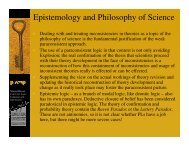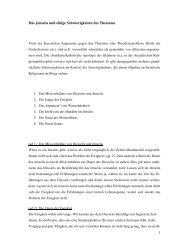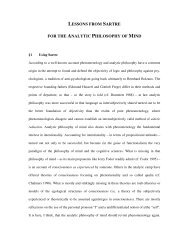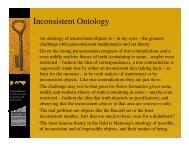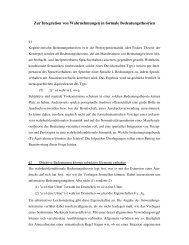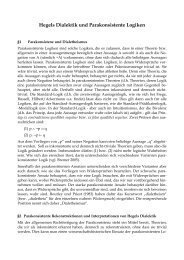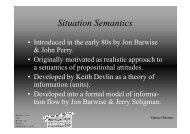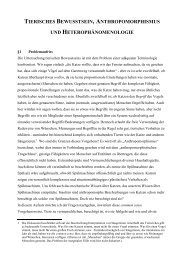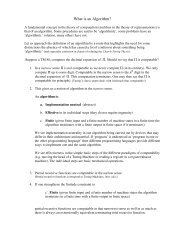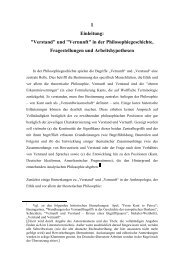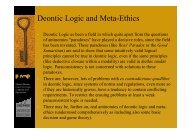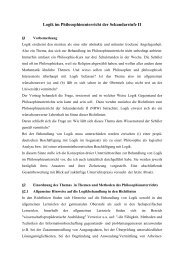Relevant Logics - Bremer
Relevant Logics - Bremer
Relevant Logics - Bremer
Create successful ePaper yourself
Turn your PDF publications into a flip-book with our unique Google optimized e-Paper software.
p ∧¬<br />
∧¬ ∧¬p ∧¬<br />
∧¬<br />
Manuel <strong>Bremer</strong><br />
Centre for Logic,<br />
Language and<br />
Information<br />
<strong>Relevant</strong> <strong>Logics</strong><br />
• <strong>Relevant</strong> <strong>Logics</strong> (RL, in America also called "Relevance <strong>Logics</strong>") are<br />
one of the major groups of paraconsistent logics. <strong>Relevant</strong> logics are a<br />
subset of the paraconsistent logics (i.e. the requirements to be <strong>Relevant</strong><br />
are stronger than only avoiding Explosion).<br />
• The essential aim of <strong>Relevant</strong> Logic is to capture a natural and<br />
intuitive appropriate concept of entailment, one for which the<br />
paradoxes of implication (or similar ones) do not appear.<br />
• The very earliest axiomatization of a paraconsistent logic by Orlov was<br />
in fact a <strong>Relevant</strong> logic. The development known today as Relevance<br />
Logic started in the USA in the 1960s with work done by Anderson,<br />
Belnap, Dunn and Meyer, and resulted in two volumes entitled<br />
Entailment. In the 1970s Routley, Meyer, Brady and others developed<br />
in Australia their version of <strong>Relevant</strong> Logic and semantics. This issued<br />
in two volumes <strong>Relevant</strong> <strong>Logics</strong> and their Rivals.<br />
• We are interested in <strong>Relevant</strong> Logic here as a means to define a<br />
conditional that keeps Modus Ponens and its other essential properties,<br />
but does not fail on the conditions we proposed for paraconsistent<br />
logics (e.g. the Curry Conditions).
p ∧¬<br />
∧¬ ∧¬p ∧¬<br />
∧¬<br />
Manuel <strong>Bremer</strong><br />
Centre for Logic,<br />
Language and<br />
Information<br />
Propositional <strong>Relevant</strong> <strong>Logics</strong><br />
• The defining properties of <strong>Relevant</strong> <strong>Logics</strong> concern the propositional<br />
level, so we will focus on propositional systems here [cf. Chap. 4].<br />
• [At the end of this chapter we introduce the quantificational logic<br />
DJ d Q, since we will need it as a quantificational logic in the chapter on<br />
set theory.]
p ∧¬<br />
∧¬ ∧¬p ∧¬<br />
∧¬<br />
Manuel <strong>Bremer</strong><br />
Centre for Logic,<br />
Language and<br />
Information<br />
Defining <strong>Relevant</strong> <strong>Logics</strong><br />
• RLs not just avoid Explosion, all Irrelevant theorems and consequence<br />
relationships of PC (and standard modal logics with an Irrelevant strict<br />
implication) should be avoided.<br />
• These include all versions of Explosion like<br />
(1) A ⊃ (¬A ⊃ B)<br />
(2) A ∧ ¬A ⊃ B<br />
and all versions of verum ex qoudlibet sequitur like<br />
(3) A ⊃ (B ⊃ B) or<br />
(4) B ⊃ (A ⊃ B) [resp. B |⎯ (A ⊃ B)]<br />
• What have all these sentences in common?<br />
(If there is one such property, excluding it will yield only <strong>Relevant</strong><br />
implications.)<br />
• The diagnosis of proponents of RLs is that in all these sentences the<br />
consequent ultimately to be detached is a sentence that has no<br />
connection in content to the antecedent sentences. That there is no<br />
connection in content can be seen in the propositional case by the fact<br />
that given the full logical structure at the propositional level the<br />
consequent and the antecedent share no propositional letters.
p ∧¬<br />
∧¬ ∧¬p ∧¬<br />
∧¬<br />
Manuel <strong>Bremer</strong><br />
Centre for Logic,<br />
Language and<br />
Information<br />
Defining <strong>Relevant</strong> <strong>Logics</strong> (II)<br />
• This observation led to the variable sharing requirement (speaking of<br />
a letter for a basic sentence as a "propositional variable").<br />
• This leads to the following definitions:<br />
(R1) Only those conditional theorems are <strong>Relevant</strong> in which<br />
the antecedent and the consequent share a propositional<br />
variable.<br />
(R2) Only those consequence relationships are <strong>Relevant</strong> in<br />
which the premises and the conclusion share a<br />
propositional variable.<br />
(R3) Just those logics are <strong>Relevant</strong> which have only <strong>Relevant</strong><br />
theorems and and <strong>Relevant</strong> consequence relationships.<br />
• Requirement (R1) is necessary, since given the validity of Modus<br />
Ponens any Irrelevant theorem would spread its Irrelevance.<br />
• Seen in the light of these definitions LP is not a <strong>Relevant</strong> logic if we<br />
consider "⊃" as its conditional.<br />
• We will not discuss the adequacy and philosophical background of<br />
these definitions in detail here. We will see what sticking to these<br />
properties requires, and whether we are willing to go this way.
p ∧¬<br />
∧¬ ∧¬p ∧¬<br />
∧¬<br />
Manuel <strong>Bremer</strong><br />
Centre for Logic,<br />
Language and<br />
Information<br />
First Degree Entailment<br />
• <strong>Relevant</strong> <strong>Logics</strong> aim at a concept of entailment that is stronger than the<br />
material conditional.<br />
• The first approach could be to keep the material conditional as the<br />
usual abbreviation of ¬A ∨ B and consider |⎯ as formalising<br />
entailment. |⎯, of course, is a stronger relation than "⊃". Alternatively<br />
once could require entailments A → B to be of first degree only (i.e.<br />
there are no nested arrows →).<br />
• This approach was taken in the late 1950s by Anderson and Belnap.<br />
The system is called First Degree Entailment (FDE).<br />
• One can give a tree-characterisation of this system by rules similar to<br />
the rules we used in chapter 4 for LP; this system also allowing for<br />
truth value gaps. The resulting logic is in fact a sub-logic of LP (since<br />
LP allows for some Irrelevant deductions). FDE has no theorems at<br />
all! Its logic resides completely in the consequences that hold in it.<br />
• The fundamental shortcoming of this system – besides being even<br />
weaker than LP – is that it does not allow to model nested entailments,<br />
whereas many intuitive logical truths for the conditional (Permutation,<br />
Transitivity etc.) are just that.<br />
• [For a brief tree-based introduction to FDE see (Priest 2000, Chap.8).]
p ∧¬<br />
∧¬ ∧¬p ∧¬<br />
∧¬<br />
Manuel <strong>Bremer</strong><br />
Centre for Logic,<br />
Language and<br />
Information<br />
Example <strong>Relevant</strong> Logic<br />
• Let us look at system with a nestable conditional connective "→".<br />
• The system DL ("dialectical logic") is used by (Routley/Meyer 1976)<br />
in a paraconsistent context:<br />
• Axiom schemata:<br />
(A1) A → A<br />
(A2) (A → B) ∧ (B → C) → (A → C)<br />
(A3) A ∧ B → A<br />
(A4) A ∧ B → B<br />
(A5) (A → B) ∧ (A → C) → (A → B ∧ C)<br />
(A6) A ∧ (B ∨ C) → (A ∧ B) ∨ (A ∧ C)<br />
(A7) ¬ ¬A → A<br />
(A8) (A → ¬B) → (B → ¬A)<br />
(A9) A → A ∨ B<br />
(A10) B → A ∨ B<br />
(A11) (A → C) ∧ (B → C) → ((A ∨ B) → C)<br />
(A12) ¬A ∧ ¬B → ¬(A ∨ B)<br />
(A13) ¬ (A ∧ B) → ¬A ∨ ¬B<br />
Rules: (R1) A, A → B B<br />
(R2) A → B ¬B → ¬A
p ∧¬<br />
∧¬ ∧¬p ∧¬<br />
∧¬<br />
Manuel <strong>Bremer</strong><br />
Centre for Logic,<br />
Language and<br />
Information<br />
Example <strong>Relevant</strong> Logic (II)<br />
• In these logics the consequence relation only inherits truth from the<br />
premises to the conclusion (and so it's done in a derivation). The<br />
conditional "→" expresses a stronger relation. It expresses the<br />
obtaining of some connection between the antecedent and the<br />
consequent. Because of this it is not valid that<br />
(*) |⎯A → B if A|⎯B<br />
The Deduction Theorem generally does not hold for entailment.<br />
[To have a Deduction Theorem the reading of A 1 ,...A n |⎯B has to be<br />
changed (taking the left hand side as a "multiset") and further<br />
connectives are introduced like an intensional conjunction (called<br />
"fusion") and disjunction (called "fision"), but all this is beyond our<br />
current interests.]<br />
• As you see, these logics need quite more axioms than standard logics,<br />
since a lot of proofs are no longer available. For example distribution<br />
needs a special axiom (A6). We need two axioms, (A12) and (A13), to<br />
establish the DeMorgan dualities. With respect to negation (A7) shows<br />
its standard character. Note also that contraposition has to be taken as a<br />
rule of its own right.
p ∧¬<br />
∧¬ ∧¬p ∧¬<br />
∧¬<br />
Manuel <strong>Bremer</strong><br />
Centre for Logic,<br />
Language and<br />
Information<br />
No Binary Accessibility<br />
• The greatest challenge for <strong>Relevant</strong> logicians is to give a semantics<br />
that makes exactly the consequence of the axioms given true.<br />
• Usually modal logics (i.e. logics that model a stronger conditional) use<br />
a possible worlds semantics. A typical truth conditional for a strict<br />
conditional (with the set of possible worlds W) is:<br />
(*S→) v(A → B,w) = 1 iff<br />
(∀w'∈W)(Rww' (v(A,w') v(B,w'))<br />
This rule makes A → A a logical truth. This is O.K., since (A1) says<br />
so, but it also makes B → (A → A) a logical truth, and this sentence is<br />
Irrelevant, since B and A → A share no propositional variables.<br />
• The problem is combining the supposedly obvious truth of sentences<br />
like A → A with avoiding Irrelevance. A binary accessible relation<br />
seems to be unable to keep them apart.<br />
• Therefore many <strong>Relevant</strong> logics have a ternary accessibility relation!<br />
• To model inconsistency not only consistent, but also inconsistent<br />
worlds are considered, even worlds in which the laws of logic are<br />
thought to be out of force. (This is modelled by not applying the usual<br />
rules of the connectives to these worlds.)
p ∧¬<br />
∧¬ ∧¬p ∧¬<br />
∧¬<br />
Manuel <strong>Bremer</strong><br />
Centre for Logic,<br />
Language and<br />
Information<br />
Ternary Accessibility<br />
• A model is a tuple M= consisting of the actual<br />
world @, the set of normal worlds (those worlds in which logic holds),<br />
the set of all worlds (normal or not), the accessibility relation, the<br />
monadic *-operation, a domain of objects (in the quantificational case<br />
[we are not considering here]), and an interpretation v.<br />
• We require:<br />
1. @ ∈N ⊆ W<br />
2. D ≠ ∅ (in the quantificational case)<br />
3. A is true in some Model M' iff v'(A,@)=1<br />
This last requirement states that we assess the truth of a sentence<br />
relative to the actual world only. All other worlds are only operative in<br />
determining the truth conditions of a sentence. This may be justified by<br />
considering that we want to know which sentences are true, and a<br />
sentence is true (in distinction to its being logically true) if it is true in<br />
the obtaining world (i.e. the actual world).
p ∧¬<br />
∧¬ ∧¬p ∧¬<br />
∧¬<br />
Manuel <strong>Bremer</strong><br />
Centre for Logic,<br />
Language and<br />
Information<br />
Ternary Accessibility (II)<br />
• The semantic rules are the usual ones for the connectives with the<br />
exception of the intensional negation rule (see below) and the rule for<br />
the truth of entailments in terms of ternary accessibility:<br />
(R→) v(A→B,w)=1 ⇔<br />
(∀w',w'')(R(w,w',w'') ∧ v(A,w')=1 v(B,w'')=1)<br />
An entailment is true at some world if this world sees an accessibility<br />
between two other worlds such that if A is true at the first of these<br />
worlds B is true at the other.<br />
• For normal worlds a further requirement is stated:<br />
(NC) (∀w,w',w'')(w∈N ∧ R(w,w',w'') w' = w'')<br />
This serves to recover the idea that under normal conditions an<br />
entailment just is true if in all accessible worlds the truth of the<br />
antecedent guarantees the truth of the consequent.<br />
• The normality condition is important in its application to @ and in<br />
regaining a model of intuitive entailment as normal implication.
p ∧¬<br />
∧¬ ∧¬p ∧¬<br />
∧¬<br />
Manuel <strong>Bremer</strong><br />
Centre for Logic,<br />
Language and<br />
Information<br />
Ternary Accessibility – Example<br />
• As an example let us see why A→(B→B) is no longer a logical truth:<br />
Since we are free to interpret atomic formula at worlds and the truth<br />
condition (R→) refers to 3 worlds of evaluation, we can have<br />
v(B,w')=1 and v(B,w'')=0, being accessible from w''', thus B→B being<br />
false at w''', thus with @ being the actual world of some model<br />
accessing a world w'''' where A is true and w'''' accessing w''',<br />
R(@,w'''',w'''), we have according to (R→) made A→(B→B) false!<br />
• That B→B is false at w''' does not matter, since only @ matters for<br />
assessing truth in a model. B→B cannot be made false at @, since the<br />
normality condition (NC) has it that for a normal world the seen<br />
accessing and accessed world are identical.
p ∧¬<br />
∧¬ ∧¬p ∧¬<br />
∧¬<br />
Manuel <strong>Bremer</strong><br />
Centre for Logic,<br />
Language and<br />
Information<br />
Some Binary Accessibility<br />
• Further requirements re-introduce a binary accessibility relation ≤ for<br />
two worlds w and w':<br />
4. w ≤ w' iff (∃w''∈N)(R(w'',w,w')<br />
That is worlds are binary accessible only if some normal world "sees"<br />
the accessing.<br />
• Given this definition in 4.<br />
5. w ≤w<br />
6. w ≤w'∧ R(w',w'',w''') R(w,w'',w''')<br />
This preserves the seeing of accessibility from an accessed world to the<br />
accessing world.<br />
• The next requirement ensures double negation:<br />
7. w = w**<br />
8. w≤w' w'*≤w*<br />
This last supports contraposition.
p ∧¬<br />
∧¬ ∧¬p ∧¬<br />
∧¬<br />
Manuel <strong>Bremer</strong><br />
Centre for Logic,<br />
Language and<br />
Information<br />
Some Binary Accessibility (II)<br />
• " ≤" defines a binary accessibility relation in terms of R and normal<br />
worlds. One can uses this relation to model a concept of entailment<br />
that expresses that the truth of the antecedent necessitates the truth of<br />
the consequent. Thus we define a common notion of entailment:<br />
(DE) A entails B ⇔ (∀w∈W)(v(A,w)=1 v(B,w)=1)<br />
To achieve expressing this within <strong>Relevant</strong> semantics using the ternary<br />
R and the binary ≤ we add a further heredity requirement:<br />
9. v(A,w)=1 ∧ w ≤ w' v(A,w')=1<br />
and we define normal implication as:<br />
(DNI) A normally implies B ⇔ (∀w∈N)(v(A→B,w)=1)<br />
Normal implication thus is <strong>Relevant</strong> implication in the normal worlds<br />
only. Interestingly enough now one can prove an important metalogical<br />
theorem:<br />
(MT1) A entails B iff A normally implies B.<br />
• The non-normal worlds, however, are essential to <strong>Relevant</strong> semantics<br />
(to invalidate Irrelevant theorems for "→"). We forbid that the actual<br />
world of a model is a non-normal world, but maybe we shouldn't!<br />
• So the set of normal implications need not match the set of true<br />
conditionals A→B of a model (and, of course, of the logic as a whole).
p ∧¬<br />
∧¬ ∧¬p ∧¬<br />
∧¬<br />
Manuel <strong>Bremer</strong><br />
Centre for Logic,<br />
Language and<br />
Information<br />
Ternary Accessibility?<br />
• (MT1) expresses that given normality the <strong>Relevant</strong> entailments<br />
coincide with our "usual" entailments (of binary accessibility modal<br />
logics). <strong>Relevant</strong> entailment itself, however, is different.<br />
• What does (R→) tell us?<br />
This seems quite unclear. No intuitive reading is obvious. But if the<br />
semantics is not justifiable with respect to our intuitive concept of<br />
entailment, the whole approach using a ternary accessibility relation<br />
seems questionable. Even <strong>Relevant</strong> Logicians [cf. Anderson/Belnap/Dunn<br />
1992, pp. 163-64] summarize that (R→) has no intuitive basis and no<br />
connection to our ordinary understanding of the conditional!<br />
• Even the definition of the binary accessibility relation ≤ (cf.<br />
requirement 4) has no intuitively obvious justification.<br />
• There is, however, a new promising reading of the ternary accessibility<br />
relation in terms of the theory of information (flow).<br />
[Before we look at this we look at the Routley semantics of negation.]
p ∧¬<br />
∧¬ ∧¬p ∧¬<br />
∧¬<br />
Manuel <strong>Bremer</strong><br />
Centre for Logic,<br />
Language and<br />
Information<br />
The Routley Star<br />
• To give a semantics for negation that allows for true contradictions<br />
Richard Routley introduced his (in)famous star operator. Negation<br />
becomes an intensional connective.<br />
• Each world w is accompanied by a witness world w*.<br />
• The rule for negation is:<br />
(*¬) v(¬A,w)=1 iff v(A,w*)=0<br />
• Once again the evaluation of a sentence is spread across worlds.<br />
Note that nothing is said whether the behaviour of A (i.e. unnegated)<br />
depends on what is the case at w*.<br />
• Example:<br />
We can have v(A,w)=1, v(A,w*)=v(B,w)=0 giving us that<br />
A ∧ ¬A →B turns out false, since w is a world where A and ¬A are<br />
true (i.e. being non-normal) and B isn't. Explosion fails.
p ∧¬<br />
∧¬ ∧¬p ∧¬<br />
∧¬<br />
Manuel <strong>Bremer</strong><br />
Centre for Logic,<br />
Language and<br />
Information<br />
The Routley Star (II)<br />
• It is hard to see any intuitive sense in the witness world and the rule for<br />
negation.<br />
• The construction validates the theorems, but it has been considered by<br />
many logicians as a formal trick only [for example, cf. (van Bentham<br />
1979)].<br />
• As in the case of the ternary accessibility relation there is also a new<br />
reading of the Routley star in terms of information theory based on<br />
situation semantics.
p ∧¬<br />
∧¬ ∧¬p ∧¬<br />
∧¬<br />
Manuel <strong>Bremer</strong><br />
Centre for Logic,<br />
Language and<br />
Information<br />
Information Flow Semantics<br />
• A more justifiable semantics for negation and the relevant conditional<br />
can be given in the framework of information flow (the theory of<br />
distributed systems and information channels) based on the framework<br />
of situation semantics.<br />
• [It is not possible to throw in quickly an introduction to that field as well.<br />
There are some other Powerpoint based lectures, however, that do that. See<br />
http://manuel.bremer.bei.t-online.de/situationsemantics.htm<br />
on situation semantics in general. And see on information flow and channels<br />
http://manuel.bremer.bei.t-online.de/BarwiseSeligmanESSLII.htm]<br />
• Information flows in distributed systems (like a circuit that connects a<br />
switch with a bulb). These systems can be considered channels along<br />
which we reason (like knowing that the switch was pressed if the bulb<br />
is burning).<br />
• Talking in situation semantics language we can say that information<br />
about one situation is derived from another situation by some channel.<br />
• Situations are parts of reality. The channel is also a part of reality<br />
(trivially so if we see the distributed system as a channel). Therefore<br />
there is a situation that comprises exactly the channel.
p ∧¬<br />
∧¬ ∧¬p ∧¬<br />
∧¬<br />
Manuel <strong>Bremer</strong><br />
Centre for Logic,<br />
Language and<br />
Information<br />
Information Flow Semantics for →<br />
• The infons made factual by that situation are the infons that describe<br />
the structure of the channel. The important thing is: The channel as<br />
well as the parts (be it two or more) are situations and can be relata of<br />
a ternary relation connecting entities of some type. The channel and<br />
two sites connected by a channel can be seen as the relata of the<br />
ternary accessibility relation R. Look again at the truth condition of<br />
"→": The relation that is said to hold between w' and w'' is established<br />
or observed from w. Let w be the channel and w' and w'' be the sites<br />
connected by the channel. We can say that the channel establishes the<br />
connection between the sites, and from the perspective of the<br />
distributed system the sites are relata of information flow.<br />
• A→B receives the following interpretation: A→B is true at w if all the<br />
sites/situations w' and w'' connected by that channel are such that if the<br />
information A is available at the one end w the information B is<br />
available in situation w''. The more constraints hold for a distributed<br />
system the less situations can be derived from it, since the derived<br />
situations have to meet all the constraints. Having more constraints<br />
operative in a channel means zooming in on a very specific<br />
part/situation.
p ∧¬<br />
∧¬ ∧¬p ∧¬<br />
∧¬<br />
Manuel <strong>Bremer</strong><br />
Centre for Logic,<br />
Language and<br />
Information<br />
Information Flow Semantics for → (II)<br />
• This amounts to an interpretation of a ternary accessibility relation in<br />
terms of information flow. And it allows us to introduce a second<br />
reading of "→" (besides the usual one).<br />
• (R→2) A→B is true with respect to a channel c iff<br />
{A} ⎯ C {B} is a constraint for that channel c.<br />
• To spell out this reading there should be infomorphisms mapping what<br />
is said in A and B at the system level to statements/infons of the part<br />
classifications. An interpretation also has to be developed for the<br />
equivalent of the occurrence of nested arrows "→". It seems that one<br />
has to allow constraints that constrain lower level constraints.<br />
• Edwin Mares gives a further interpretation of "→" in terms of<br />
situations and information flow exploiting the fact that an infon (made<br />
true by some situation) can contain information about situations (i.e.<br />
contain parameters or constants for situations).
p ∧¬<br />
∧¬ ∧¬p ∧¬<br />
∧¬<br />
Manuel <strong>Bremer</strong><br />
Centre for Logic,<br />
Language and<br />
Information<br />
Information Flow Semantics for → (III)<br />
• An infon can contain information about relations between infons and<br />
situations. Infons of this kind are informational links. They tells us that<br />
some infon being factual involves a second infon being factual. An<br />
informational link has the form: where Φ and Ψ<br />
are situation types.<br />
• One can take R to represent these informational links. If some<br />
informational link is said to hold in situation w saying that an infon φ<br />
(of type Ψ) carries the information that the infon ϕ (of type Φ) also has<br />
to hold (somewhere), then if R(w,w',w'') and w' contains/supports the<br />
infon φ, then w'' contains/supports the infon ϕ. The ternary relation<br />
models an informational link of one situation/infon constraining<br />
another. Thus (taking → here for a moment as connecting infons):<br />
(R→3) φ → ϕ is true with respect to situations w, w', w'' such that<br />
R(w,w',w'') if it is true that if w|= and<br />
w'|= φ , then w''|= ϕ.
p ∧¬<br />
∧¬ ∧¬p ∧¬<br />
∧¬<br />
Manuel <strong>Bremer</strong><br />
Centre for Logic,<br />
Language and<br />
Information<br />
Information Flow Semantics for → (IV)<br />
• If we take R to be about or related to informational links some features<br />
of information linkage should be mirrored by the relation R. Every<br />
situation is closed under informational linkage, since information is<br />
factual. This means for relation R that one should require it to be<br />
reflexive: R(w,w,w)<br />
• The set of statements made true by w is closed under Modus Ponens<br />
then.<br />
• Note that reflexivity does not make obvious sense, however, in the<br />
second reading of "→": Not every channel carries information from<br />
itself to itself! On the other hand it seems vacuously true, since the<br />
information present in the system is present in the system (as its own<br />
improper part) if it is present in the system (as its own part).
p ∧¬<br />
∧¬ ∧¬p ∧¬<br />
∧¬<br />
Manuel <strong>Bremer</strong><br />
Centre for Logic,<br />
Language and<br />
Information<br />
Information Semantics for *<br />
• What about negation? If the situation framework could deal with the *operator<br />
as well it might well become the preferred reading of<br />
<strong>Relevant</strong> truth conditions!<br />
• A piece of information can be incompatible with another piece of<br />
information. This may be due to the polarities within the infons<br />
supported by the situation or due to constraints yielding implied<br />
information of the one infon incompatible with the other. Suppose we<br />
had made this intuition more precise and given a formal account of<br />
compatibility, say by using infon logic or by considering metalogical<br />
properties of the theories of distributed systems (i.e. their set of<br />
supported constraints).<br />
• We could introduce then a relation C(w,w') of compatibility between<br />
situations or the sets of infons supported by these situations. The<br />
statement ¬A is true at w, then, if the truth of A is incompatible with<br />
the other information contained in a related situation w'. The closure of<br />
a situation can be taken as what the situation says. The set of<br />
compatible situations can be taken as that which is not excluded by<br />
what the situation says.
p ∧¬<br />
∧¬ ∧¬p ∧¬<br />
∧¬<br />
Manuel <strong>Bremer</strong><br />
Centre for Logic,<br />
Language and<br />
Information<br />
Information Semantics for * (II)<br />
• If the negation of some state of affairs A is a fact in all w compatible<br />
situation, the state of affairs is not compatible with w, so presumably<br />
its negation is contained within what w says. w* (the witness world)<br />
can be taken as the maximal situation such that the information given<br />
in w is compatible with it. We arrive at:<br />
• (R*2) v(¬A,w)=1 ⇔ (∀w')(C(w,w') v(A,w')=0)<br />
That is a negation is true in a situation w if in all other situations<br />
compatible with the information given in w the statement under<br />
consideration is false. w* just is the most informative (since most<br />
comprehensive) of these situations. Not every situation is compatible<br />
with itself, since we assumed that there are inconsistent situations.<br />
• So a situation framework may also give us a more intuitive<br />
understanding of the *.<br />
• Note, however, that this requires spelling out the relation C in an<br />
acceptable way. Sometims this relation is just taken as basic [e.g.<br />
(Mares 2004, p. 77)]!
p ∧¬<br />
∧¬ ∧¬p ∧¬<br />
∧¬<br />
Manuel <strong>Bremer</strong><br />
Centre for Logic,<br />
Language and<br />
Information<br />
Worlds and Situations<br />
• The information (flow) semantics outlined was developed in terms of<br />
situations.<br />
• Situations – in contrast to possible worlds – are partial. They do not<br />
contain A or ¬A for every sentence A of the language. They are not –<br />
in case we don't require this otherwise – closed under some rules.<br />
• Especially situations (in contrast to situation types) can be taken as<br />
parts of the universe. Taken thus it makes sense to say that some<br />
situations are connected or parts of a greater distributed systems.<br />
• The same cannot be said for worlds. Worlds are not only total, only<br />
one of them is actual. Different possible worlds stand in no causal or<br />
part-whole relation whatsoever.<br />
• Therefore it might be crucial to rephrase the whole semantics into talk<br />
about situations and situation types.<br />
• This change to partiality might, however, conflict with the information<br />
semantics for *, since assessments of compatibility may require<br />
closure of the situations under consideration.<br />
• So more work has to be done here. We have seen so far the idea of<br />
such a semantics. [More complications arise when the partiality of the<br />
situation framework is combined with quantificational semantics in an<br />
intensional framework of world relative domains.]
p ∧¬<br />
∧¬ ∧¬p ∧¬<br />
∧¬<br />
Manuel <strong>Bremer</strong><br />
Centre for Logic,<br />
Language and<br />
Information<br />
Systematization<br />
• The typical systems of <strong>Relevant</strong> Logic can be systematized as being<br />
extension of a basal <strong>Relevant</strong> logic B.<br />
• B is defined by the following axiom schemes and rules:<br />
(A1) A → A<br />
(A2) A → A ∨ B<br />
(A3) B → A ∨ B<br />
(A4) A ∧ B → A<br />
(A5) A ∧ B → B<br />
(A6) A ∧ (B ∨ C) → (A ∧ B) ∨ (A ∧ C)<br />
(A7) (A → B) ∧ (A → C) → (A → B ∧ C)<br />
(A8) (A → C) ∧ (B → C) → ((A ∨ B) → C)<br />
(A9) ¬ ¬A → A<br />
(R1) A, A → B B [Modus Ponens]<br />
(R2) A, B A ∧ B [∧I]<br />
(R3) A → B (C → A) → (C → B) [Prefixing]<br />
(R4) A → B (B → C) → (A → C) [Suffixing]<br />
(R5) A → ¬B B → ¬A [Contraposition]
p ∧¬<br />
∧¬ ∧¬p ∧¬<br />
∧¬<br />
Manuel <strong>Bremer</strong><br />
Centre for Logic,<br />
Language and<br />
Information<br />
Systematization (II)<br />
• The systems that extend B are called affixing systems, since they all<br />
share the pre- and suffixing rules.<br />
• Candidates for further axiom schemes are:<br />
(A10) (A → ¬B) → (B → ¬A)<br />
(A11) (A → B) → ((C → A) → (C → B))<br />
(A12) (A → B) → ((B → C) → (A → C))<br />
(A13) (A → ((A → B) →B)<br />
(A14) (A → (A →B)) → (A → B)<br />
• (A10) – (A12) are the theorem versions of the rules (R3)-(R5). (A13)<br />
is a version of the Modus Ponens theorem, (A14) Absorption (or<br />
"Contraction").<br />
• All of these are not valid in B. One can define the systems:<br />
DW = B + (A10) [(R5) can be dropped then]<br />
TW = DW + (A11) + (A12) [drop (R3) and (R4)]<br />
RW = TW + (A13) [drop (A11) or (A12)]<br />
R = RW + (A14)<br />
• R being the strongest of these systems contains all PC-theorems! The<br />
interesting question is which theorems hold for "→" (not "⊃").
p ∧¬<br />
∧¬ ∧¬p ∧¬<br />
∧¬<br />
Manuel <strong>Bremer</strong><br />
Centre for Logic,<br />
Language and<br />
Information<br />
Restrictions on R<br />
• The systems that extend B validate more sentences by excluding more<br />
countermodels by requiring further properties of the relation R (as<br />
stronger modal logics in general work by restricting accessibility).<br />
• For example:<br />
- making Prefixing as an axiom true corresponds to:<br />
(∀w',w'',w''',w'''')((∃w ∈W)(R(w',w'',w) ∧ R(w,w''',w''''))<br />
(∃w''''' ∈W)(R(w',w''',w''''') ∧ R(w'',w''''',w''''))).<br />
- making Contraction as an axiom true corresponds to:<br />
(∀w',w'',w''')(R(w',w'',w''')<br />
(∃w ∈W)(R(w',w'',w) ∧ R(w,w'',w'''))<br />
• Both this requirement on R have no intuitive sense and can hardly be<br />
rephrased to make them obvious. The affixing theorems, however,<br />
look pretty natural. Why do they demand such strange restrictions?<br />
• These conditions on R also have most unfortunate consequences. They<br />
employ nested existential quantification. If one uses them in a tree like<br />
decision procedure this results in branches of infinite length. In fact in<br />
can be proven that even <strong>Relevant</strong> propositional logic is, therefore,<br />
undecidable! It can be really hard to ascertain what holds in system R.
p ∧¬<br />
∧¬ ∧¬p ∧¬<br />
∧¬<br />
Manuel <strong>Bremer</strong><br />
Centre for Logic,<br />
Language and<br />
Information<br />
Relevance of B ... R<br />
• The systems that extend B up to R are indeed <strong>Relevant</strong> in the sense<br />
that in a logically true conditional the variable sharing requirement is<br />
met.<br />
• This can be shown (using some strange 8-valued semantics) for R.<br />
Given that it holds for the strongest of these systems, it has to hold for<br />
all of them.<br />
[cf. (Priest 2001), pp.197-98, and p.209 for a much simpler proof for logic B.]<br />
• [Note that taking some strange semantics – that is not the intended<br />
semantics of our system – to prove this fact is admissible: First one<br />
proves that R is sound with respect to the strange semantics; then one<br />
shows that given some such semantics Irrelevant conditionals are not<br />
logically true; so, given the soundness of R, they cannot be proven; if<br />
they cannot be proven (a syntactic meta-property), they cannot be<br />
proven in the intended semantics either! This method of using arbitrary<br />
(non-intended) semantics to prove meta-theorems is often employed in<br />
paraconsistent metalogic.]
p ∧¬<br />
∧¬ ∧¬p ∧¬<br />
∧¬<br />
Manuel <strong>Bremer</strong><br />
Centre for Logic,<br />
Language and<br />
Information<br />
Brady's Logic of Entailment<br />
• Ross Brady proposes the following system as a <strong>Relevant</strong> logic that<br />
captures the intuitive notion of entailment. Its semantics is modelled on<br />
the idea of containment of content. The basic idea is that a content is<br />
connected to each sentence and the relation of entailment is that of<br />
containment of content.<br />
• Brady's logic is important, since he considers it to be a universal logic<br />
that can be employed in any context [see Chap. 20]. He uses it for his<br />
version of paraconsistent set theory [see Chap. 11].<br />
• Brady's logic, called DJ d Q, is very weak and has to assume axioms for<br />
relations derivable otherwise.<br />
• Brady's logic does neither use the ternary accessibility relation nor the<br />
Routley star *. That, too, makes it worth looking at.
p ∧¬<br />
∧¬ ∧¬p ∧¬<br />
∧¬<br />
Manuel <strong>Bremer</strong><br />
Centre for Logic,<br />
Language and<br />
Information<br />
DJ d Q – Axioms<br />
• Axiom schemes:<br />
(A1) A → A<br />
(A2) A ∧ B → A<br />
(A3) A ∧ B → B<br />
(A4) (A → B) ∧ (A → C) → (A → B ∧ C)<br />
(A5) A → A ∨ B<br />
(A6) B → A ∨ B<br />
(A7) (A → B) ∧ (C → B) → (A ∨ C → B)<br />
(A8) A ∧ (B ∨ C) → A ∧ B ∨ A ∧ C<br />
(A9) ¬ ¬A → A<br />
(A10) (A → ¬B) → (B → ¬A)<br />
(A11) (A → B) ∧ (B → C) → (A → C)<br />
(A12) (∀x)P(x) → P(á)<br />
(A13) (∀x)(A → P(x)) → (A → (∀x)P(x)) *<br />
(A14) (∀x)(A ∨ P(x)) → (A ∨ (∀x)P(x)) *<br />
(A16) P(á) → (∃x)P(x)<br />
(A17) (∀x)(P(x) → A) → ((∃x)P(x) → A) *<br />
(A18) A ∧ (∃x)P(x) → (∃x)(P(x) ∧ A) *<br />
* [x not free in A]
p ∧¬<br />
∧¬ ∧¬p ∧¬<br />
∧¬<br />
Manuel <strong>Bremer</strong><br />
Centre for Logic,<br />
Language and<br />
Information<br />
DJ d Q – Rules<br />
• Rules: (R1) A → B, A B<br />
(R2) A, B A ∧ B<br />
(R3) A → B, C → D (B → C) → (A →D)<br />
(R4) A (∀x)A<br />
• Meta-Rules (MR1) If A B then also A ∨ C B ∨ C<br />
(MR2) If A B then (∃x)A (∃x)B<br />
where in both meta-rules in the derivation A B (R4) does not<br />
generalize on a free variable in A.
p ∧¬<br />
∧¬ ∧¬p ∧¬<br />
∧¬<br />
Manuel <strong>Bremer</strong><br />
Centre for Logic,<br />
Language and<br />
Information<br />
DJ d Q – Semantics<br />
• We start with contents: The content of a set of sentences Γ are all the<br />
sentences that can be analytically established from the terms occuring<br />
in the sentences in Γ. Often we take Γ to be a singleton {A}.<br />
• The range of Γ is the set of all sentences that analytically ensure that at<br />
least one sentence in Γ is true.<br />
• Each sentence A corresponds a set of sentences c(A), which is its<br />
content (the analytic closure of A). The content set of A can be taken<br />
as a great conjunction. A|=B for B ∈c(A) is analytic.<br />
• Each sentence corresponds a set of sentences r(A), which is its range.<br />
The range set of A can be taken as a great disjunction.<br />
• The logical operations can be semantically modelled by algebraic<br />
operations on these (content) sets. Every basic sentence is assigned<br />
some content. The content of A ∧ B is the set of analytic consequences<br />
of the union of c(A) and c(B). The content of A ∨ B is c(A) ∩ c(B).<br />
• Entailment is now semantical defined as containment of content:<br />
v(A→B)=1 iff c(B) ⊆ c(A).<br />
• To ensure a <strong>Relevant</strong> logic postulates for content relations are laid<br />
down, e.g. c(A ∨ B) = c(A) ∩ c(B) ⊆ c(A).
p ∧¬<br />
∧¬ ∧¬p ∧¬<br />
∧¬<br />
Manuel <strong>Bremer</strong><br />
Centre for Logic,<br />
Language and<br />
Information<br />
DJ d Q – Semantics (II)<br />
• An exception to this algebra is negation, since taking negation as set<br />
complement would give A ∧¬A universal content, and would validate<br />
Explosion and verum ex qoudlibet for entailment. The negation of a<br />
sentence can be better understood as all those sentences that represent<br />
alternative situations, i.e. the content of ¬A are all facts the absence of<br />
which made A possible: c(¬A) := {B|¬B ∈r(A)}. This set is c(A)*.<br />
The interpretation v assigns c(A)* to ¬A.<br />
• The semantics of entailment – taking it as content containment – seems<br />
to be close to our natural understanding of entailment. Nothing about<br />
accessing the accessibility of worlds is involved.<br />
• This semantics – obviously – presupposes a theory of establishing the<br />
analytic consequences of a given sentence, i.e a theory of analyticity!<br />
This may require meaning postulates, which in turn may contain<br />
expressions (like "→") the semantics of which operates on contents!<br />
A meaning postulate – usually a conditional – may look like the<br />
prototypical entailment. Basic content assignment (at the beginning of<br />
the interpretation semantics) may not be so basic at all.
p ∧¬<br />
∧¬ ∧¬p ∧¬<br />
∧¬<br />
Manuel <strong>Bremer</strong><br />
Centre for Logic,<br />
Language and<br />
Information<br />
DJ d Q – Metalogic<br />
• Sentences with identical contents can always be substituted for each<br />
other. (For contained meaning semi-substitutivity in a context holds.)<br />
• DJ d is sound and complete relative to the semantics of contents.<br />
[cf. (Brady 1996)].<br />
• Several typical theorems do not hold in DJ d Q:<br />
Contraction, the Law of Excluded Middle [A ∨ ¬A], Disjunctive<br />
Syllogism, the Modus Ponens Theorem, nor (A → ¬A) → ¬A.<br />
• Therefore DJ d Q satisfies the Strong Anti-Triviality Condition.
p ∧¬<br />
∧¬ ∧¬p ∧¬<br />
∧¬<br />
Manuel <strong>Bremer</strong><br />
Centre for Logic,<br />
Language and<br />
Information<br />
Assessment<br />
• The established systems of <strong>Relevant</strong> logic capture at least parts of our<br />
concepts of relevance and entailment.<br />
• The most pressing problem is to give an intuitively convincing<br />
semantics for entailment and negation within the RL context. The<br />
Routley star is a cross violation of the Extensionality condition.<br />
Semantic work seems to be still going on; the focus on information<br />
theory may prove to be useful.<br />
• We cannot take some RL to be our target logic for paraconsistency if it<br />
fails on the Strong Anti-Triviality Condition. Neither can be take a<br />
logic that validates Contraposition in general (as we will see in Chap.<br />
16). The typical systems B, R, E are, therefore, not available to us.<br />
• For an assessment of the information (flow) semantics consider<br />
questions (Q1), (Q2), and remember the note on situations vs. worlds.<br />
• One of the most promising of the logics presented here is DJ d Q. It<br />
satisfies the Strong Anti-Triviality condition. It has Contraposition, but<br />
this depends on a corresponding postulate on content semantics, that<br />
might be dropped.
p ∧¬<br />
∧¬ ∧¬p ∧¬<br />
∧¬<br />
Manuel <strong>Bremer</strong><br />
Centre for Logic,<br />
Language and<br />
Information<br />
Assessment (II)<br />
• Another – also major – problem with <strong>Relevant</strong> Logic from a<br />
philosophical perspective is that it treats ex contradictione quodlibet<br />
and verum ex quodlibet as being on a par.<br />
• This is not clear at all: ex contradictione quodlibet seems (a) intuitively<br />
implausible [we just don’t reason that way] and (b) would be<br />
disastrous if valid. Both points do not hold that obviously for verum ex<br />
quodlibet: certainly it would not be disastrous if valid, contra (b); and<br />
it need not be intuitively implausible, we just don’t care to give more<br />
reasons for what is already established as valid, contra (a).<br />
• Many of the more contrived semantic manoeuvres in <strong>Relevant</strong> Logic<br />
are tied to avoiding some form of verum ex quodlibet sequitur. We can<br />
avoid all these troubles simply accepting verum ex quodlibet, as many<br />
paraconsistent logics do.
p ∧¬<br />
∧¬ ∧¬p ∧¬<br />
∧¬<br />
Manuel <strong>Bremer</strong><br />
Centre for Logic,<br />
Language and<br />
Information<br />
Questions<br />
• (Q1) Consider the information flow characterization of the<br />
ternary accessibility relation. Given that it is an<br />
appropriate characterization of accessibility relations<br />
within distributed systems (information channels) does<br />
it by this provide an analysis/model for our concept of<br />
semantic entailment?<br />
• (Q2) Consider the characterization of the Routley star in<br />
terms of compatible (completed) situations. Given that<br />
this is a good characterization of negation, is it truthfunctional<br />
or intensional or neither of them? How to we<br />
ascertain the truth of ¬A? If every situation was<br />
compatible with itself, what would this imply for<br />
Explosion?<br />
• (Q3) Why is the content of A ∨ B less than the content of the<br />
single sentences: c(A) ∩ c(B) (i.e. the cut and not the<br />
union c(A) ∪ c(B))?
p ∧¬<br />
∧¬ ∧¬p ∧¬<br />
∧¬<br />
Manuel <strong>Bremer</strong><br />
Centre for Logic,<br />
Language and<br />
Information<br />
Exercises<br />
• (Ex1) Using the truth condition (R→) show that verum ex<br />
qoudlibet sequitur, A→(B→A), is not a logical truth.<br />
• (Ex2) Show that given the restriction on R associated with<br />
Contraction (A14) cannot be invalidated.<br />
• (Ex3) Why is the Modus Ponens theorem not valid in the<br />
content semantics of DJ d Q? Consider the closure<br />
conditions of contents (what do they involve and what<br />
do they not involve), and the content of the conjunction<br />
A ∧ (A → B).
p ∧¬<br />
∧¬ ∧¬p ∧¬<br />
∧¬<br />
Manuel <strong>Bremer</strong><br />
Centre for Logic,<br />
Language and<br />
Information<br />
Further Reading<br />
• On <strong>Relevant</strong> <strong>Logics</strong> in general you may look in the two volumes of<br />
Entailment (ed. by A. Anderson et al.) or the two volumes of <strong>Relevant</strong><br />
<strong>Logics</strong> and their Rivals (ed. by R. Routley, R. Brady et al.), but for a<br />
introduction to these logics you better use: Read, Steven. <strong>Relevant</strong><br />
Logic. Oxford, 1994. A short introduction you find in (Priest 2000). A<br />
philosophical introduction and discussion you find in: Mares, Edwin.<br />
<strong>Relevant</strong> Logic. A Philosophical Interpretation. Cambridge, 2004.<br />
• The idea of a information (flow) semantics for <strong>Relevant</strong> logics you can<br />
find in:<br />
109 (1996), pp. 345-60; and:<br />
! "<br />
# $ % &<br />
'(() ** +),-.. /<br />
%0 " '((.&1 2 %$ '(('&<br />
3 0 4 * 5<br />
6 7 2 %0 8999& ** '',-,)<br />
3 : ** ;2<br />
% * '((



